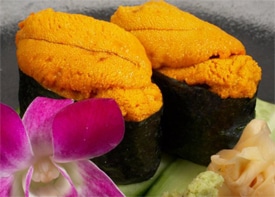Uni Sushi (Sea Urchin)
What is Uni?

It is nevertheless one sushi item that is in incredible demand around the world, which is reflected in its price. Sea Urchins are a rare treat for those who acquire a taste. Uni sushi has a light, sweet, and somewhat briny flavor and is is usually enjoyed as nigiri sushi or sashimi.
Uni sushi is also sometimes served with a raw quail egg. Uni is also considered an aphrodisiac by some. It is harvested throughout the world, however the west coast of the U.S. has in recent years become one of the largest sources, and much of the harvest finds its way overseas to eager Asian customers.
Each sea urchin contains five ‘lobes’ and the harvesting of the uni is a very delicate process as the meat easily falls apart. Uni is a somewhat seasonal item and is at its best when served from late fall through the winter, with December considered the best month by Japanese standards.
Amanda Tan who started the famous Zairyo (“ingredients”), an extremely popular Japanese grocery store in Singapore, is all about seasonal foods. As she realized that the more people were exposed to Japanese foods, the more they began to enjoy them.
Yes, even uni, which has had Westerners on one side of the fence or the other since it first started appearing on Western menus.
The Different Grades of Uni Sushi
Uni has historically been graded based on color, texture, and freshness. There are three primary grades, that take into account variables such as color, texture, size, and overall appeal. From “best” to “still good but not perfect, the grades are:
- Grade A Uni – This is the highest grade and is a bright yellow/gold (Grade A) with a firm texture and somewhat sweet. It is obviously the most sought after as the texture, color, sweetness, and overall flavor and presentation is impeccable. This grade is uni in its purest form
- Grade B Uni – This is a more muted yellow and has a softer texture and is less sweet, but still has a pleasant flavor, and offers a subdued but similar experience as grade A, It is often combined with other items, or not served on its own as while it is still a tasty experience, if you’re used to grade A, it’s not quite the same.
- Grade C Uni – This is referred to as ‘vana’ and is often the parts left over from uni that has broken apart during processing or handling. It is rarely eaten “as is” but is used to flavor dishes, from pastas to soups, or anything that may benefit from the unique “sea and umami” flavor that sea urchin may impart. While some look down on this particular grade, it can add an incredible depth of flavor to dished.
Sea Urchin Quality And Pricing
Obviously, the higher the grade, the higher the price, and fresh uni taken directly from a living sea urchin will command the highest price (and is worth the experience as uni this fresh is noticeably different from uni that was processed 24 plus hours beforehand).
Uni is also available fresh (nama uni), frozen (reito uni), baked and frozen (yaki uni), steamed (mushi uni), and salted (shio uni), which is usually reserved for the lower grades of uni. Uni is also available as neri uni (blended urchin paste) and tsubi uni (a lumpy paste). The color and quality of uni is largely dependent on its diet, gender, and time of harvest. Size is also important as some lobes of uni can be too large for a piece of sushi.
Meshiagare!
I have always been fascinated by the creation and culture of different foods, particularly sushi and sashimi in the modern era of Japanese cuisine. I am a classically trained chef and sushi connoisseur, also having operated a food service company and enjoy investigating and experimenting with food around the world.